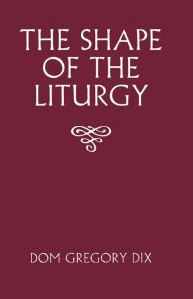The great Anglican liturgical historian, Gregory Dix, published this fantastic study of the history of the Christian liturgy (though he humbly refers to it as an introduction) in January 1945 while World War 2 was still raging. At over 750 pages in small print it’s not one of those books you finish over the weekend but it’s well worth the read. It’s hard to speed-read, but this is because of its interesting content rather than its difficulty.
Dix examines the development of the liturgy giving ample attention to the ante-Nicene Church about which I was thrilled. His style isn’t especially breath-taking but it’s readable, simple, and always easy to understand. You never have to read a sentence twice and with so many sentences to read – that is warmly welcomed.
His historical work is excellent. No one could accuse him of being unfair, except perhaps those from within his own tradition. That is to say, he takes special care to deal with alternative views as fairly as possible. He’s always scientific and never overreaches the evidence. Only an expert in liturgical history would walk away not having received a thorough education. In fact, I don’t really have anything negative to say about the book except that it dragged on a bit at the end.
Anglicans will be particularly interested in the second to last chapter which deals exclusively with the development of the Anglican liturgy from the 16th century until the early 19th. Dix is decidedly not a fan of Cranmer and concludes that he is essentially Zwinglian in his Eucharistic theology. Dix also has a few strong opinions about the direction modern Anglican liturgy should take. From what I understand, some more traditionally minded Anglicans have taken issue with him on these points but that is a fight in which I do not have a dog. For what it’s worth, he convinced me.
From a Catholic standpoint, one thing of particular interest was Dix offers a real picture into the mind of the pre-Vatican II theologians and some of the perceived issues which Vatican II sought to address. Even though Dix was not a Catholic, he was a renowned scholar respected by experts in this field from various communions. His scholarship exemplifies the best of 20th century liturgical historians and he was a real player in the liturgical restoration movement of the early 20th century. The importance of rightly understanding the liturgical action of the early Church is something Dix stresses repeatedly and the language he uses to describe it is recognizable for those familiar with the actual intentions of the fathers of the Second Vatican council.
I would highly recommend this book to anyone interested in developing a strong, overall history of the development of the liturgy.
